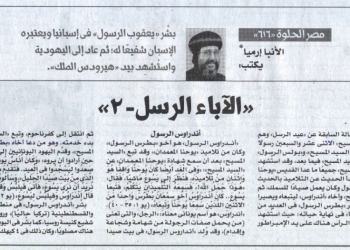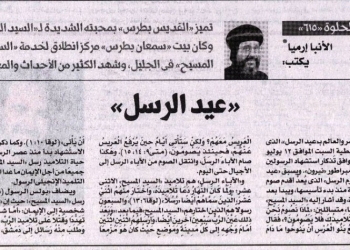Last article tackled Pope Mikhail II (1092- 1102) who passed away out of plague, during his days, the Commander of Armies died, and was succeeded by his son; Al-Afdal. After the death of Caliph Al-Mustansir Billah (427- 487 AH) (1036- 1094 AD), his son Al-Musta’li Billah assumed the throne. Previous articles stated that the Abbasid state then was under the rule of Caliph Al-Muqtadi bi amr Allah (467- 487 AH) (1075- 1094 AD), who restored glories to the state and was famous for mettle, courage and piety. His supporters were the Seljuk Sultan Malik-Shah, the In-charge of the State Affairs; he was known for his courage, justice and correct opinion, as well as Minister Nizam Al-Dawla who was described as “one of the greatest scholars, a pious virtuous lover of knowledge and scholars”; thus, the Abbasid state became of great importance at that epoch. In 485 AH (1092 AD), Nizam Al-Dawla was killed and Malik-Shah died; followed by the death of Caliph Al-Muqtadi Billah in 487 AH (1094 AD); Then his son Al-Mustazhir Billah took over the affairs of the caliphate.
Caliph Abu Al Abbas Ahmed “Al-Mustazhir Billah” (487- 513 AH) (1094- 1118AD)
He is the 28th Caliph of Abbasid State; he assumed caliphate after the death of his father Al-Muqtadi Billah at the age of nearly sixteen. He ruled for more than two decades; Professor Hassan Khalifa, Professor of History and Economics, stated: “Al-Mustazhir Billah assumed the throne of the state along about twenty-four years, during which serious incidents occurred in the Islamic kingdom east and west.”; There was turmoil in the east as conflicts raged between the princes of the “Seljuk State” and its sultans, which led to their division and their power was undermined, besides their preoccupation with internal wars and civil revolutions. As for the west, the Abbasid state was preoccupied with confronting the Franks’ attempts (historically known as the “Crusades”) to seize Jerusalem (Bait al-Maqdis), which was indeed occupied in 492 AH (1099/1098 AD). Thus, the political and civil conditions were disturbed and worsened throughout the Abbasid state, especially with the spread of the esoteric (Batiniyah) call in Isfahan in 492 AH (1099/1098 AD), and its escalation in Iraq in 494 AH (1100 AD) after the supporters of this call excessively killed people, to an extent that the princes wore shields under their clothes to kill the people!
The Seljuk State in the Era of Al-Mustazhir Billah
After the death of Sultan Malik-Shah, the Seljuk State began to suffer turmoil; internal wars and unrest erupted all over it, and wars erupted between Sultan Barkiaruk and his uncle, Taj al-Dawla Tuch ibn Alp Arslan, the founder of the Seljuk state in Syria. After the death of Taj al-Dawla, revolts broke out between the two brothers, Barkiaruk and Muhammad, their dispute and fighting continued until 498 AH. Despite the death of Barkiaruk, unrest among the Seljuk princes did not cease until the death of Sultan Muhammad in 511 AH (1117 AD).
Al-Mustazhir Billah fell ill, diagnosed with prosoplasia disease, then he died at the age of forty-one and a half years, after being a caliph for twenty-four years and few months. Ibn Al-Atheer said about him: “He was soft-spoken, of generous morals, he liked to seek benevolence towards people, and did works of good, and was hasting towards doing works of righteousness and rewards, praised for his endeavors, and he did not drive away any honor asked from him. He trusted those whom he assigned, turning a deaf ear to gossips, paying no attention to them, he maintained no fickleness, nor he ever lost mettle due to the words of the purposeful people… He had a good handwriting and good signatures, imitated by nobody, indicating abundant virtue and wide knowledge.” He was eloquent and poetry composer. Ibn al-Atheer comments on the death of Caliph Al-Mustazhiar Billah: “It is an astonishing chance for these incidents to occur consequently: Sultan Alp Arslan died, then followed by Al-Qa’im bi Amr Allah. When Sultan Malik-Shah died, Al-Muqtadi Bi-Amr Allah died afterwards, and when Sultan “Muhammad” died, he was followed by Al-Mustazhir Billah”!
Historians have agreed that the days Al-Mustazhir Billah were pervaded with turmoil and wars, and… Stories in beautiful Egypt never end!
General Bishop
Head of the Coptic Orthodox Cultural Center


 العربية
العربية












